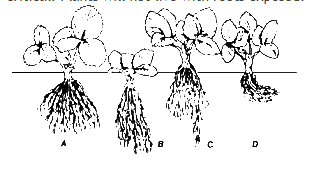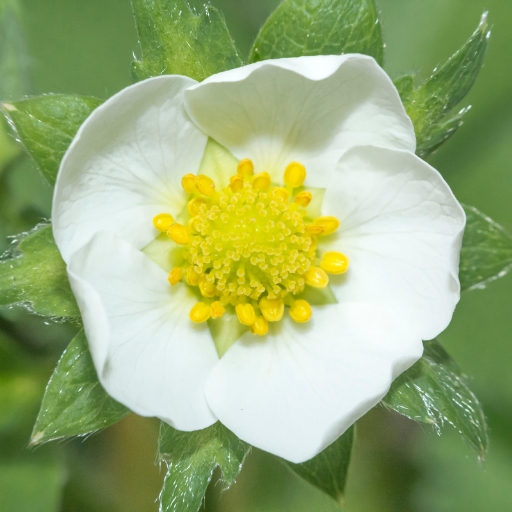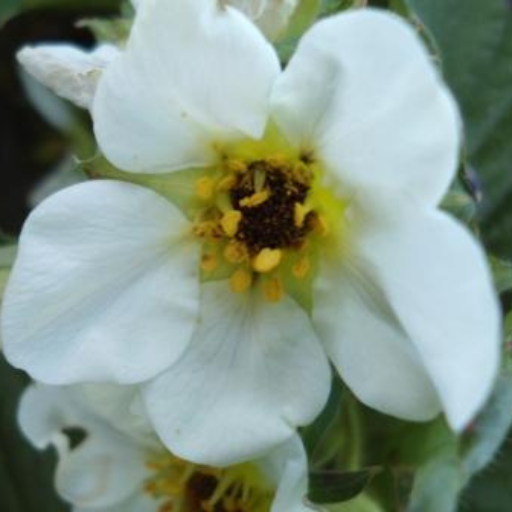Strawberry All Season Collection. 4 varieties, 100 total plants
Extend your strawberry season by planting four different early to late varieties.
25 of each, Galletta, Flavorfest, Jewel & AC Valley Sunset.
100 Total Plants.

Extend your strawberry season by planting four different early to late varieties.
25 of each, Galletta, Flavorfest, Jewel & AC Valley Sunset.
100 Total Plants.
ATTENTION: Cannot ship plants to the state of California.
June Bearers: Planted early spring, produce fruits during the second year of planting. June-bearing strawberries produce a large crop lasting 2-4 weeks, in late spring early summer. Depending upon your location strawberry plants usually begin flowering in Zone 5 areas in early May. Cultivars are rated as early, midseason, or late according to when they bear. Early varieties may be more subject to frost injury because of their bloom time, and the opened blossom is at the stage of fruit development most susceptible to frost injury. Strawberry varieties all ripen about 30 days after bloom. June-bearing strawberries normally produce the largest yield per season, in a short period of time. If you want enough berries for freezing and processing choose June Bearers.
June-bearing varieties flourish in the spring and produce one crop lasting about 2-4 weeks. They are planted the first year and produce a full crop the second year. If properly cared for, can be productive for 3-7 years.
| Fruit | Planting Distance (1) | Planting Distance (1) | Interval from Planting to Fruiting | Full Production | Life of Plants | Height of Mature Plants | Est. Annual Yield |
| Between Rows (ft) | Between Plants (ft) | Years | Years | Years | Feet | Per Plant | |
| Strawberry - June Bearer | 31/2-4 | 18"-24" | 1 | 1 | 3-8 | 1 | 1/2-1qt |
(1) = Minimum suggested spacing.
Strawberries can be grown in most soil types; however, a good well-drained loam soil will consistently produce a better crop. Select an area that will receive full sun most of the day. Avoid shaded areas and any place where water will stand after a rain as standing water can greatly increase frosts.
Do not grow strawberries for five or more consecutive years on the same site without some type of crop rotation. Do not plant strawberries in areas where tomatoes, potatoes, peppers, or eggplant have been grown within the past four years. These vegetables carry the root rot fungus Verticillium, which also attacks strawberries.
In addition, do not plant strawberries into recently plowed grass sod areas which can lead to devastating weed problems and damage by white grubs, a common turf pest that feeds on strawberry roots.
Plant Spacing: 18'-24" in between each plant. 3 1/2 to 4 ft. in between rows. Cultivate the soil several times 2 weeks prior to planting to eliminate weeds. Each time you do this you will eliminate many freshly germinated weeds. It is best to plant strawberries as early in the spring as the soil is workable. Cold temperatures are unlikely to damage dormant plants.
Typical time of planting times is from February to early April in the south, March and April in the northern states. If you order plants and receive in before ready or weather conditions are not ideal, as long as you set box on a cool dark place such as a basement or garage, they should be okay for 7-10 days. Plants will keep up to 4 weeks in kept at 35 degrees. Check moisture levels of the roots frequently, if the roots are dry, you will need to mist them but be careful not over water them. Remove most of the old leaves from each plant. Use a trowel to make a hole by pressing it back and tipping to both sides.
Spread the roots carefully and firm the soil around the roots. Set the plants at the correct depth. Do not trim roots and do not bend roots to fit into the hole. The base of the crown should be at the level of the soil surface. Plant too deep will smother and die; plant too high will dry out. Spread the roots and carefully firm the soil around the roots leaving no air pockets. If the soil is dry, pour a pint of water around each plant. DO NOT FERTILIZE AT THE TIME OF PLANTING. You should see new growth in 7-10 days.

Proper planting method A
Improper planting methods B, C, D
The objective the first year is to establish a good row of plants. Approximately 30 days after planting the plant will produce flowers. These flowers should be pinched or cut off. Do not pull them off. Removing the flowers prohibits the plants from fruiting and as a result, encourages more runners earlier in the season - setting the stage for a higher yielding crop the second year. These runners need to be pulled into the row and then they "peg" or grow roots and become new plants. To properly peg a new plant you may have to help it by digging through the straw mulch and press the runner tip into the ground. The runner will only root when it comes in contact with the soil. These new plants are what will produce fruit next year. You should try to place a new plant every 6" in every direction in a matted row that is 12-18 inches wide.
Allowing plants to be closer than 6" will crowd the plants which will result in smaller fruit. Remove all new runners that form after mid-August as these will not have time to peg and produce a good plant.
DO NOT ALLOW YOUR BED OVERPOPULATE. Keep weeds under control. Unfortunately, the best ways to do this is by hand and hoe. In the fall, after 3 hard frosts or hard freeze, you should cover your planting with a straw mulch. This is typically around Thanksgiving in northern Indiana. This protects the plants from extreme winter cold as well as moderating the temperature to stabilize the plants environment. Mulch the plants by shaking the straw evenly over the row until you can no longer see any of the green of the plant through the covering of straw.
Remove the straw mulch in early spring (when growth starts). DO NOT ALLOW PLANTS TO TURN YELLOW UNDER THE STRAW. Remove the straw by parting it slightly allowing for a narrow row 12-18 inches wide to grow up through the mulch. Keeping the parted straw up against the narrow row will allow the fruit to sit on a straw bed while ripening. This will create a barrier to protect the fruit from splashing dirt.
This is important as many of the fruit rots come from the soil. The thick straw mulch between rows ill also help in weed control. DO NOT APPLY ANY FERTIIZER IN THE SPRING as it will soften the fruit.
Spring frosts can often kill the blossoms. Even a light frost can have a devastating effect on yield. Remember to cover or protect your patch in some way just as you might sensitively flowers or tomato plants. Small green fruit are seldom damaged by frosts.
Strawberry Blossom Strawberry Frost Damage Blossom.


Keep the planting well-watered (1" per week) while the crop is maturing.
As berries ripen, keep the picked. Allowing over ripe fruit to remain in the patch can attract beetles that will become a nuisance. Go over the patch every 2 to 3 days picking the fruit at maximum ripeness. It is normal for berry size to decrease as the season progresses. The later fruit is smaller but the flavor is usually great and these make great jam and freezer berries.
A crucial step in maintaining a productive berry patch is renovating. This is a 3 step process performed each year as soon after harvest as possible that rejuvenates your planting and is essential if you want to have a long lived productive patch.
Step 1: Set the mower blade on your lawn mower at a setting that will remove the leaves from the strawberry plant but won't damage the crowns. Trimming off the old leaves will decrease the disease problems for the rest of the summer. If this step is delayed and runners begin to grow, skip the step. Waiting too long to mow off the leaves will damage next year's yield.
Step 2: Lightly fertilize your patch with a balanced 12-12-12 fertilizer at 2lbs. per 100 square feet.
Step 3: Till between the rows narrowing down the row to 10-12 inches. This is very hard for many people as they think they are destroying their patch. Thinning or narrowing the row will keep your plants healthy and productive by allowing more sunlight and airflow throughout the row.
After renovation, keep your planting free of weeds and mulch with straw in the fall. Repeat each year for many years of great strawberries. Once you see a significant decrease in yield from one year to the next it is time to replant. For some people this is every 3 years but for other it can be every 5 to 7 years.
The first season after new growth starts (when runners start) side dress with 1 lb. per 100 square feet. In Mid-August side dress with 1 lb. per 100 square feet.
The second year and subsequent years after, broadcast with 2-3 lbs. of fertilizer at renovation and in Mid-August side dress with 1 lb. per 100 square feet.
CAUTION: MAKE SURE FERTILIZER DOES NOT LODGE ON THE LEAVES; FERTILIZER CAN BE SWEPT OFF THE PLANTS, THIS IS NESESSARY TO PROTECT THE PLANTS FROM LEAF BURN.
| Berry Variety | # Of Days After Earliglow | Flavor | Berry Size | Firmness | Resistant | Zone | |
| Early | Earliglow | 0 | Excellent | S-M | Firm | R, V, LC | 4-8 |
| Early | AC Wendy | 0 | Very Good | L | Firm | R, LS, LC | 3-8 |
| Early | Annapolis | 2 | Very Good | VL | Firm | R | 3-8 |
| Early | Galleta | 0 | Very Good | L | Firm | R, LS, LC | 4-7 |
| Mid-Season | Allstar | 9 | Very Good | VL | Firm | R, V, LS, LC | 4-8 |
| Mid-Season | Archer | 8 | Excellent | VL | Firm | R | 4-8 |
| Mid-Season | Cabot | 9 | Good | VL | Firm | R | 4-8 |
| Mid-Season | D'Light | 5 | Very Good | VL | Firm | N/A | 5-8 |
| Mid-Season | Flavorfest | 7 | Very Good | VL | Firm | R, V, LS, LC | 4-7 |
| Mid-Season | Honeoye | 6 | Good | VL | Firm | R, V, LS, LC | 4-8 |
| Mid-Season | Keepsake | 7 | Very Good | L | Firm | R, V, LS, LC | 4-8 |
| Late Season | AC Valley Sunset | 14 | Very Good | L | Mod Firm | R, V, LS, LC | 4-8 |
| Late Season | Dickens | 14 | Excellent | L | Firm | N/A | 4-7 |
| Late Season | Jewel | 12 | Very Good | L | Very Firm | R, V, LS, LC | 4-8 |
| Day Neutrals Everbearers | Albion | N/A | Very Good | VL | Very Firm | R, V, LS, LC | 4-8 |
| Day Neutrals Everbearers | Monterey | N/A | Very Good | VL | Very Firm | R, V, LS, LC | 4-8 |
| Day Neutrals Everbearers | San Andreas | N/A | Very Good | VL | Firm | R, V, LS, LC | 4-8 |
| Day Neutrals Everbearers | Seascape | N/A | Very Good | L | Firm | R, V, LS, LC | 4-8 |
Berry Size: S = Small, M = Medium, L = Large, N/A = Info Not Available
Resistance: R = Red Stele, V = Verticillium, LS = Leaf Spot, LC = Leaf Scorch
Plants Required Per Acre
Plants Required Per Acre
| Rows | Distance in Row | Plants Per Acre |
| 3 ft. Apart | 3 in. | 58,000 |
| 3 ft. Apart | 4 in. | 43,900 |
| 3 ft. Apart | 6 in. | 29,000 |
| 3 ft. Apart | 12 in. | 14,625 |
| 3-1/2 ft. Apart | 18 in. | 8,325 |
| 3-1/2 ft. Apart | 24 in. | 6,225 |
| 4 ft. Apart | 18 in. | 7,300 |
| 4 ft. Apart | 24 in. | 5,425 |
| 4 ft. Apart | 30 in. | 4,375 |
* FOR ADDITIONAL PRICING & PRODUCT INFORMATION CLICK ON THE ITEM.
* DISCOUNTS FOR MIX AND MATCH PRICING WILL BE CALCULATED IN THE CART.
* YOU MUST SELECT A SHIPPING METHOD AT THE CART TO COMPLETE YOUR ORDER.
*PLEASE CONTACT US WITH ANY QUESTIONS OR CONCERNS 800-295-2226, WE ARE HAPPY TO HELP, WE APPRECIATE AND THANK YOUR BUSINESS.